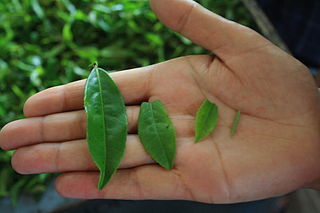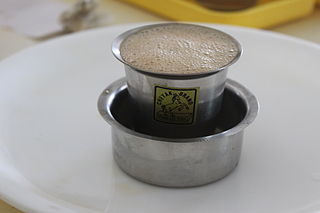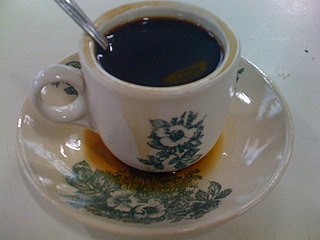
Beer is one of the oldest and the most widely consumed type of alcoholic drink in the world, and the third most popular drink overall after water and tea. It is produced by the brewing and fermentation of starches, mainly derived from cereal grains—most commonly from malted barley, though wheat, maize (corn), rice, and oats are also used. During the brewing process, fermentation of the starch sugars in the wort produces ethanol and carbonation in the resulting beer. Most modern beer is brewed with hops, which add bitterness and other flavours and act as a natural preservative and stabilizing agent. Other flavouring agents such as gruit, herbs, or fruits may be included or used instead of hops. In commercial brewing, the natural carbonation effect is often removed during processing and replaced with forced carbonation.

Bubble tea is a tea-based drink that originated in Taiwan in the early 1980s. Taiwanese immigrants brought it to the United States in the 1990s, initially in California through regions like Los Angeles county, but has likewise spread to other countries where there is a large East Asian diasporic population.

A drink or beverage is a liquid intended for human consumption. In addition to their basic function of satisfying thirst, drinks play important roles in human culture. Common types of drinks include plain drinking water, milk, juice, smoothies and soft drinks. Traditionally warm beverages include coffee, tea, and hot chocolate. Caffeinated drinks that contain the stimulant caffeine have a long history.

Tea is an aromatic beverage prepared by pouring hot or boiling water over cured or fresh leaves of Camellia sinensis, an evergreen shrub native to East Asia which probably originated in the borderlands of southwestern China and northern Myanmar. Tea is also rarely made from the leaves of Camellia taliensis. After plain water, tea is the most widely consumed drink in the world. There are many different types of tea; some have a cooling, slightly bitter, and astringent flavour, while others have vastly different profiles that include sweet, nutty, floral, or grassy notes. Tea has a stimulating effect in humans primarily due to its caffeine content.

Espresso is a coffee-brewing method of Italian origin, in which a small amount of nearly boiling water is forced under 9–10 bars of pressure through finely-ground coffee beans. Espresso can be made with a wide variety of coffee beans and roast degrees. Espresso is the most common way of making coffee in southern Europe, especially in Italy, France, Spain, and Portugal. It is also popular in Switzerland, Croatia, Bosnia and Herzegovina, Bulgaria, Greece, South Africa, the United Kingdom, the United States, Canada, Australia and New Zealand.

A tea bag, or the compound teabag, is a small, porous, sealed bag or packet, typically containing tea leaves or the leaves of other herbs, which is immersed in water to steep and make an infusion. Originally used only for tea, they are now made with other tisanes as well.

Kombucha is a fermented, lightly effervescent, sweetened black tea drink commonly consumed for its purported health benefits. Sometimes the beverage is called kombucha tea to distinguish it from the culture of bacteria and yeast. Juice, spices, fruit or other flavorings are often added.

Caffè latte, often shortened to just latte in English, is a coffee beverage of Italian origin made with espresso and steamed milk. Variants include the chocolate-flavored mocha or replacing the coffee with another beverage base such as masala chai, mate, matcha, turmeric or rooibos; alternatives to milk, such as soy milk or almond milk, are also used.

Coffee is a drink prepared from roasted coffee beans. Darkly colored, bitter, and slightly acidic, coffee has a stimulating effect on humans, primarily due to its caffeine content. It is the most popular hot drink in the world.

In the tea industry, tea leaf grading is the process of evaluating products based on the quality and condition of the tea leaves themselves.

Indian filter coffee is a coffee drink made by mixing frothed and boiled milk with the infusion obtained by percolation brewing of finely ground coffee powder in a traditional Indian filter. Internationally, the drink is referred to as Madras filter coffee or South Indian filter coffee to distinguish it from drip brew coffee, which is normally known as filter coffee.

Tea culture is defined by the way tea is made and consumed, by the way the people interact with tea, and by the aesthetics surrounding tea drinking.

A kopitiam or kopi tiam is a type of coffee shop mostly found in parts of Indonesia, Malaysia, Singapore, Brunei and Southern Thailand patronised for meals and beverages, and traditionally operated by the Chinese community of these countries. The word kopi is an Indonesian and Malay term for coffee and tiam is the Hokkien/Hakka term for shop. Menus typically feature simple offerings: a variety of foods based on egg, toast, kaya, plus coffee, tea, Horlicks and Milo.

Teh tarik is a popular hot milk tea beverage most commonly found in restaurants, outdoor stalls, mamaks and kopitiams within the Southeast Asian countries of Malaysia, Indonesia, Singapore and Thailand. Its name is derived from the pouring process of "pulling" the drink during preparation. It is made from a strong brew of black tea blended with condensed milk. It is the national drink of Malaysia.

A full breakfast is a substantial cooked breakfast meal, often served in the United Kingdom and Ireland, that typically includes back bacon, sausages, eggs, black pudding, baked beans, some form of potato, tomatoes, mushrooms, toast, and a beverage such as coffee or tea. It appears in different regional variants and is referred to by different names depending on the area. While it is colloquially known as a "fry-up" in most areas of the UK and Ireland, it is usually referred to as a "full English", a "full Irish", "full Scottish", "full Welsh", and "Ulster fry", in England, the Republic of Ireland, Scotland, Wales, and Northern Ireland, respectively.

Since the 18th century, the United Kingdom has been one of the world's largest tea consumers, with an average annual per capita supply of 1.9 kilograms (4.2 lb). Originally an upper-class drink in Europe, tea gradually spread through all classes, eventually becoming a common drink. It is still considered an important part of the British identity and is a prominent feature of British culture and society.

India is the second largest producer of tea in the world after China, including the famous Assam tea and Darjeeling tea. Tea is the 'State Drink' of Assam. Following this the former Planning Commission Deputy Chairman, Montek Singh Ahluwalia had plans to officially recognise tea as the Indian "National Drink" in 2013. According to the ASSOCHAM report released in December 2011, India is the world's largest consumer of tea, consuming nearly 30% of global output. India is also the second-largest exporter of tea, after China.

Kopi, also known as Nanyang coffee, is a traditional coffee beverage found in several Maritime Southeast Asian nations. Often brewed to be highly caffeinated in strength, it is commonly served with sugar and/or milk-based condiments. This drink originated from the British Malaya era, with Hainanese cultural roots. The name of the drink is derived from the Malay term for coffee. The term Nanyang, which means "South Sea" in Mandarin, refers to Maritime Southeast Asia. Kopi culture vocabulary is grounded in Hokkien dialect as a result of historical immigration to Maritime Southeast Asia from the Minnan region in the south-eastern part of Fujian Province in Southeastern Mainland China. The beverage is usually served in coffee shops, Hawker centres and kopitiams across the region.

Masala chai is an Indian tea beverage made by boiling black tea in milk and water with a mixture of aromatic herbs and spices. Originating in India the beverage has gained worldwide popularity, becoming a feature in many coffee and tea houses.


















